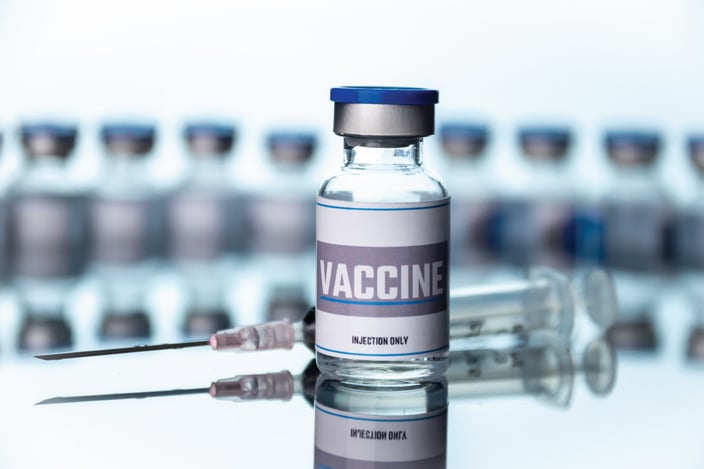n recent months, the debate on COVID-19 vaccines has become more complicated, especially with regard to their long-term efficacy. Though early studies showed COVID-19 vaccines prevented serious disease and death, new studies have raised questions about how well they provide long-term protection. Recently, an epidemiologist at the McCullough Foundation, points out a disturbing trend he says scientists have been ignoring concerning negative efficacy. Put simply, Hulscher is saying, in a few months the vaccinated, compared to the unvaccinated, may have a higher risk of reinfection.
Hulscher’s claims in Courageous Discourse are based on his analysis of four key studies a study from Iceland that kept track of SARS-CoV-2 reinfection during the Omicron wave, a Qatar-based study that assessed mRNA vaccine protection against Omicron subvariants, the Cleveland Clinic study that investigated the effectiveness of bivalent vaccines, and finally a CDC study that showed vaccine protection in young children. As proof, these studies, according to Hulscher, provide evidence that over time, immunity from vaccination may not just fade but could make individuals more susceptible to future infections.
But is Hulscher evidenced by data in his conclusions, or does it stretch the interpretation of such evidence? In this article, we examine each of these studies in detail, study their method and their results, and then we see whether they back up claims of negative efficacy. Hulscher’s interpretation will also be assessed as to whether it withstands scrutiny, bringing a balanced evidence-based view into play on this contentious issue.
Analyzing the Studies: Methodologies and Findings
In order to have a true understanding of whether the negative efficacy interpretation by Hulscher is valid, we need to further analyze the four studies he has cited. Each of these studies indicates varying aspects of vaccine efficacy; however, all have their shortcomings too. We shall examine this research individually, assessing the research methodology, findings, and conformity with Hulscher’s claims.
Study 1: Rate of SARS-CoV-2 Reinfection During the Omicron Wave in Iceland
The first study under scrutiny was conducted in Iceland, a small nation that attracted high attention for its detailed public health tracking during the course of the pandemic. The purpose of this study was to estimate the rate of reinfection by SARS-CoV-2 during the Omicron wave. The researchers intended to compare the vaccinated with the unvaccinated with regard to how immunity, from vaccination or from previous infection, held up against this new and more contagious variant.
Objective: The study aimed to determine the impact of vaccination status and previous infection on the possible reinfection with the Omicron variant that, until now, had rapidly reached worldwide dominance.
Methodology: The research team followed a cohort of individuals who had either been diagnosed with COVID-19 or received at least one dose of the vaccine. During the Omicron wave, during specific periods, reinfections were observed by collecting data on nonprior COVID-19 cases and vaccinated persons. Reinfection rates between these groups were compared accounting for the date of vaccination or previous infection.
Key Findings: Results pointed to a concerning trend-reinfection rates were higher among the vaccinated compared with the unvaccinated, especially after several months. This may indicate that immunity from vaccination does not last long as opposed to infections from previous strains of the virus. A pivotal graph in the study illustrated how reinfection rates climbed over time for vaccinated individuals, peaking significantly higher than those of unvaccinated participants. While the visual representation effectively underscored the waning of the immunity due to vaccines, some queries also raised whether some other differences in the number of tested individuals could affect outcomes.
Most importantly, the study did not exactly argue that vaccination increased the risk of reinfection; however, it simply argued that the protection given by vaccination wanes over time to make one susceptible to infection as the virus changed.
Limitations: Though the study contributes much valuable information, some limitations should also be considered:
- The study did not differentiate between those who received a booster shot and those who did not, which could have influenced the findings.
- There are also no references to other things like individual health statuses, which could also affect reinfection rates.
- Vaccination timing is also an important factor that went unexamined-there are some study participants that may have been vaccinated months or even years before the time of the Omicron wave, which makes those results skewed.
Moreover, while the study’s charts were visually compelling, they did not include confidence intervals or adjustments for some key variables, which might have helped contextualize the findings further. These gaps leave room for alternative interpretations of the data.
While the Iceland study raised concerns about waning vaccine efficacy over time, the next study from Qatar delves deeper into how mRNA vaccines fare against the Omicron subvariants, providing a more granular view of vaccine performance.
Study 2: Duration of mRNA Vaccine Protection Against SARS-CoV-2 Omicron BA.1 and BA.2 Subvariants in Qatar
The second study takes us to Qatar, whose unique population profile has been studied in close detail throughout the pandemic. This study assessed for how long mRNA vaccines (Pfizer-BioNTech and Moderna) protect against hospitalization and infection with Omicron subvariants BA.1 and BA.2, which were major drivers of the global pandemic in early 2022.
Objective: The study focused on quantification of the protection duration provided by mRNA vaccines, Pfizer-BioNTech and Moderna, against symptomatic infection with Omicron subvariants BA.1 and BA.2.
Methodology: A population-based observational study has been conducted, analyzing real-life data from Qatar’s national COVID-19 database, and included those people vaccinated with one or two or three doses of mRNA vaccines, stratifying by the time of the last dose, and observing their breakthrough infection experience during both types of virus waves compared to unvaccinated control subjects.
Key Findings: The study revealed the rapid decrease of vaccine efficacy with time. Besides strong protection shortly after the second or third dose, the efficacy against symptomatic infection rapidly decreased within a few months. By the fourth month post-vaccination, the efficacy was negligible against BA.1 and BA.2 subvariants, giving room to the assumption of data that under certain circumstances could suggest even negative efficacy—meaning that vaccinated people might actually have a slightly higher risk of getting infected compared to the unvaccinated.
A significant chart in the study highlighted this trend, with efficacy curves plunging sharply as time from the last dose increased. Particularly concerning was the suggestion that, under specific conditions, negative efficacy might occur—meaning vaccinated individuals could face a slightly elevated risk of infection compared to their unvaccinated counterparts. Although eyebrows have been raised by such a possible reversal, it is accompanied by caveats that the data may be thought to reflect differences due to exposure risk, health-seeking behavior, or unmeasured confounders.
Limitations: Like in Iceland, this study in Qatar suffers from major limitations:
- Observational data were used and could be confounded by variables modifying exposure risk for vaccinated and unvaccinated groups.
- This did not take account of masking or behavioral differences that could affect the rates of infection.
- Unfortunately, the present studies did not differentiate of individuals who received different brands of vaccines (Pfizer-BioNTech or Moderna), which may well differ in efficacy.
The graphical representation of the study data underscored these limitations. For instance, while efficacy curves illustrated the waning protection vividly, confidence intervals for these trends were not displayed prominently, raising questions about the precision of the estimates.
The Qatar study provides compelling evidence of waning immunity, but it is not the only piece of the puzzle. The Cleveland Clinic study, which evaluated the effectiveness of the bivalent COVID-19 vaccine, adds another layer to the discussion.
Study 3: Effectiveness of the Coronavirus Disease 2019 (COVID-19) Bivalent Vaccine—Cleveland Clinic Study
The third study leads us to the United States, where the Cleveland Clinic investigated the effectiveness of the bivalent COVID-19 vaccine. This vaccine was built with the aim of making individuals immune to the original strain of SARS-CoV-2 and the Omicron variant. Now, the results of the study are having all sorts of arguments on how well the newly uploaded vaccine will perform in the real world.
Objective: To evaluate the effectiveness of the bivalent COVID-19 vaccine in reducing the incidence of SARS-CoV-2 infection among healthcare personnel during the period of Omicron dominance.
Methodology: This retrospective cohort study consisted of thousands of Cleveland Clinic employees, most of whom were injected with different doses of COVID-19 vaccine. The infection risk among bivalent booster employees was compared with that of unboosted ones, while controlling for other factors including history of infection and time since immunization.
Key Findings: The study determined that the risk of SARS-CoV-2 infection was higher in people who got the bivalent vaccination than for the unvaccinated or for anyone who had some previous history of infection alone. This apparent “negative efficacy” seemed to increase over periods, especially in individuals with multiple previous doses of earlier vaccines. The data visualization from the study showed a clear stratification:
- Risk of infection rose with the cumulative number of vaccine doses, with those having received the bivalent booster facing the highest risk.
- Individuals with prior infections but no vaccination consistently showed lower infection rates across multiple observation windows.
These findings hinted at a complex interaction between cumulative vaccine exposure and immune system behavior. Could repeated vaccinations be influencing immune durability or susceptibility? While the study did not claim causation, its results sparked a fresh wave of skepticism.
Limitations: Cleveland Clinic Study has been much talked about and criticized for some of its probable weaknesses indeed.
- It was stated that the study population (healthcare workers) were at a higher risk because of their exposure, which may, therefore, have biased the results in favor of vaccinated subjects due to behavior or employment conditions.
- The researchers were very open that things found were observational and not meant to be considered as heuristic evidence of causation.
- Such confounders such as age and health status and the differences in the frequencies of testing may not be completely adjusted.
The study’s graph, which correlated dose count with infection risk, provided a striking visual representation but lacked detailed confidence intervals. This omission leaves questions about the statistical robustness of the findings.
The Cleveland Clinic study highlights an intriguing, albeit controversial, observation regarding cumulative vaccine doses and infection risk. The final study, conducted by the Centers for Disease Control and Prevention (CDC), shifts focus to a much younger population: children aged 6 months to 4 years, shedding light on vaccine protection in this vulnerable demographic.
Study 4: Protection from COVID-19 Vaccination and Prior SARS-CoV-2 Infection Among Children Aged 6 Months–4 Years (CDC Study)
The final study in this series shifts attention to one of the most vulnerable demographics-young children aged 6 months to 4 years. The specific purpose of this investigation, conducted by the Centers for Disease Control and Prevention (CDC), was to evaluate the performance of immunization with previous infections in protecting this specific group during Omicron.
Objective: To assess how effective COVID-19 vaccines and natural immunity from previous infections are at preventing symptomatic infections in children aged 6 months to 4 years.
Methodology: The study used data on COVID-19 testing among geographically diverse children in the US from September 2022 to April 2023 and compared infection rates among those who were:
- Fully vaccinated.
- Partiallyvaccinated.
- Who were unvaccinated but had prior SARS-CoV-2 infection.
- Who were unvaccinated without prior infection.
Adjustments were made for factors like age, sex, and underlying health conditions.
Key Findings: Vaccination protection waned quickly in young children with a very sharp decline in vaccine efficacy within a few months. By 6 months post-vaccination, the data suggested negative efficacy in some cases- meaning disadvantageous; they are slightly more likely to get infected than those who are unvaccinated. Previous natural infection seems to provide more durable protection than just vaccination.
Vaccinated children experienced a significant decline in protection after the first few months, suggesting that the immune boost from the vaccine did not last as long as expected.
Children with prior infection showed more durable immunity, providing stronger protection than those who were vaccinated but had no history of infection.
A data chart from the study highlighted these findings, showing the stark contrast in protection between vaccinated children and those with prior infections. The visual demonstrated the steep drop-off in vaccine efficacy after 6 months, suggesting that immunity from infection may be more robust and long-lasting.
Limitations: There are some limitations with this study, just like the others:
- The study relied on some tested data, which may be limited by underreporting of asymptomatic or not tested cases.
- Sample sizes for some subgroups (e.g., fully vaccinated with no previous infection) were smaller, and hence the statistical power available for some comparisons was reduced.
- This study did not account for behavioral factors like possible parenting decisions around exposure and vaccination/testing.
Taken together, these four studies raise pressing questions about the long-term efficacy of COVID-19 vaccines, particularly in the face of emerging variants. But do these findings align with Nicolas Hulscher’s interpretation of negative efficacy? Let us now turn to his analysis and examine whether it holds up under closer scrutiny.
For Ali, the notion of Pakistan being clubbed with China, Russia, and North Korea likely stems from the broader US–China competition.
This is not the first instance of the US targeting China and Pakistan for alleged missile-related collaborations. In October 2023, Washington imposed sanctions on three Chinese companies and one Pakistani firm, accusing them of supplying missile technology. Similarly, last September, the State Department sanctioned a Chinese research institute and several firms, alleging their involvement in Pakistan’s Shaheen-3 and Ababeel long-range systems.
Interpreting Nicolas Hulscher’s Analysis: Does the Data Support Negative Efficacy?
Nicolas Hulscher’s analysis of the findings hinges on the concept of ‘negative efficacy’, where vaccinated people are at higher risk of infection than their unvaccinated counterparts. He leans heavily on the data from these four studies to make the point that vaccines do not just fade in their protective effects, but actually leave one open to infection.
Hulscher’s Key Claims:
- Rapid Decline of Protection: Hulscher emphasizes that all four studies show a rapid decline in vaccine efficacy within months, with some even crossing into negative efficacy.
- Cumulative Doses and Risk:He highlights findings from the Cleveland Clinic study, suggesting that multiple doses may paradoxically increase infection risk. Note TrialSite reported on these studies as well involving Cleveland Clinic healthcare workers.
- Natural Immunity Outperforming Vaccines:Evidence from CDC and Qatar, according to Hulscher, shows natural immunity to be more durable than vaccine-acquired immunity.
Does the Evidence Hold Up?
-
To analyze whether Hulscher’s assertions have validity, we need to compare them to the studies’ methodologies, data, and restrictions.
- Claim of Negative Efficacy: While three of the studies (Iceland, Qatar, and Cleveland Clinic) report data suggesting negative efficacy, it is important to consider confounding factors. Observational studies are prone to biases, such as differences in testing behavior or exposure risks, which could skew results. For instance, vaccinated individuals might be more likely to test for COVID-19 than unvaccinated individuals, artificially inflating infection rates in the vaccinated group.
- Cumulative Doses and Risk: The Cleveland Clinic study does note an association between higher vaccine doses and increased infection risk, but it explicitly cautions against inferring causation. The study acknowledges potential confounders, such as higher exposure rates among healthcare workers who are more likely to be vaccinated.
- Natural Immunity vs. Vaccine-Induced Immunity: Hulscher’s argument that natural immunity is more durable aligns with findings in the CDC and Qatar studies. However, these studies do not negate the role of vaccination in preventing severe disease and death, particularly in high-risk groups.
Critical Gaps in Hulscher’s Analysis:
Hulscher’s conclusions rely heavily on the notion of causality, but none of the studies definitively establish that vaccines actively increase infection risk. The observational nature of these studies means that findings are associative, not causal. Additionally:
- He underplays the role of confounding factors, which all four studies explicitly highlight.
- There’s limited discussion on the broader benefits of vaccination, such as preventing severe outcomes, which these studies do not directly address.
Hulscher’s interpretation raises provocative questions, but it is clear that the studies have nuanced findings that require careful consideration. Let us step back and examine what these results mean in the broader context of COVID-19 vaccination policy and public health.
Interpreting Nicolas Hulscher’s Analysis: What the Studies Really Mean
Now that we have reviewed the four studies individually, we need to step back and consider how the author interprets these findings, particularly against his background regarding the “negative efficacy” of the COVID-19 vaccines. According to Hulscher, such empirical data on the said studies is a growing concern: with the passage of time, people vaccinated may become increasingly at risk for infection than those unvaccinated. Quite a strong assertion, isn’t it? So, is this true? Let us break it down.
Understanding “Negative Efficacy”
Hulscher’s interpretation gravitates around the possibility of negative efficacy – meaning that after a certain amount of time has passed, the likelihood of contracting COVID-19 is comparatively larger among those individuals who had been vaccinated than among those who were not vaccinated. Hulscher states that the vaccine’s protection diminishes over time, and in a few cases, the individual vaccinated becomes more prone to infection because of that.
There are signs from the studies we reviewed that could fortify Hulscher’s interpretation: however, a great deal of caution is needed in considering these findings. For instance, in Study 2 (Qatar) and Study 4 (CDC), we saw how quickly efficacy for mRNA vaccines diminished over the course of months while raising long-term questions on protection. Still, this inference does not coerce into “negative efficacy” as Hulscher claims. It is rather an indication that the vaccines may just be needing boosters for maintenance of effectiveness because, in some cases, natural immunity holds a stronger guarantee over time.
Analyzing Hulscher’s Perspective on Vaccine Durability
Hulscher’s viewpoint overstates the role of negative efficacy in the studies. While it is true that several of the studies point to a significant decrease in vaccine efficacy over time, this is not the same as saying that vaccines increase the likelihood of infection. For instance, Study 1 (Iceland) and Study 3 (Cleveland Clinic) indicate, indeed, that vaccinated individuals are at a greater risk of reinfection or breakthrough over time. This is not, however, to say that such reinfection was necessarily a result of the vaccination. It shows that immunity, either via vaccination or natural infection, fades after a time and is also less effective against rapidly emerging variants such as Omicron.
Hulscher’s focus on the idea of “negative efficacy” may also be overlooking some key factors that influence vaccine effectiveness, such as booster doses, behavioral differences, and timing. Most studies never disaggregated the subjects into groups of having received booster injections or not, which explains some cases of increased reinfection risk among vaccinated individuals.
The Issue of Comparison: Vaccinated vs. Unvaccinated
One of the more important points that Hulscher’s work introduces is an apparent assumption that all studies allow direct comparison of the vaccinated and unvaccinated groups. The reality, however, has many more variables included, and there is much at play in terms of health status, age, and risk for exposure. For instance, in the study at Cleveland Clinic, these were healthcare workers, further adding to an already high exposure risk to the virus. Another confounder may point toward a skewed result in favor of the vaccinated, as they tend to behave more cautiously than their unvaccinated counterparts who might exhibit pattern of much riskier exposure.
A More Nuanced Take on the Data
While Hulscher’s interpretation provides a compelling narrative, it is not entirely supported by the data. This article suggests vaccine efficacy declines over the time, but none of them could carry the “negative efficacy” effect in the sense posited by Hulscher. Real life is far more complex: vaccines may not offer indefinite protection at all, but they continue to implement enormous benefits and even stronger ones by addition of booster doses. It is known that natural immunity may in certain cases provide even more durable protection but does not necessarily mean the vaccine is bad.
In other words, while reading Hulscher is important, the evidence we reviewed here suggests claims need reinterpretation. That is, the vaccines are not ineffective or harmful, but rather that their effectiveness wanes over time and revaccination, elevated risk behavior restrictions or other such measures may be needed to sustain protection.
While the studies discussed raise important concerns about vaccine efficacy and possible negative outcomes, the broader context of vaccine benefits, including prevention of severe disease and the role of boosters, must also be considered as we look toward the bigger picture.
Conclusion: The Complexity of Vaccine Efficacy and the Path Forward
Data reviewed in the present studies creates a very contradictory picture of vaccine effectiveness especially with respect to the newly emerging Omicron variants as well as with reference to the evolving nature of the SARS-CoV-2 virus. While initial vaccine doses provide protection against symptomatic infection as well as more serious morbidity, the data consistently show a marked decline in efficacy over time, especially when considering newer variants. In fact, in some instances, this picture may begin to resemble what some have dubbed “negative efficacy,” wherein vaccinated individuals have a greater risk for reinfection than unvaccinated individuals.
However, such evidence should not be interpreted in an isolated way. The negative efficacy observed in these studies can be explained by several factors, including different timing of vaccinations, participants having no boosters, or different behaviors between the vaccinated and unvaccinated groups. There is, however, an additional complexity because of the effect of immunity gained through previous infections and how this interacts with current vaccination status.
Analysis of these studies by Nicolas Hulscher has also drawn attention to these trends, though he comes to the same conclusion on waning protection, one of the inherent caveats of the studies. Without consideration to behaviors, timing of vaccinations, and other confounding factors, the efficacy of vaccines and its waning thereof may not be as straightforward a narrative as they might like us to believe.
The path ahead requires targeted, more specific investigations and incorporating a more diverse understanding of how vaccines interact with the immune system over time. As the virus continues to mutate, it is critical to keep refining our approach to vaccines, including evaluating booster doses and the effectiveness of vaccines against emerging variants. Yet the ongoing studies would need to accommodate real-life factors such as behavior changes and risk factors, as well as what part hybrid immunity (a combination of vaccination and prior infection) plays in influencing future strategies of COVID-19 vaccination.
While valuable in reducing severe cases and hospitalizations, the fact that this virus is changing will suggest that a continued vigilant, data-driven approach will be required for ensuring future optimal outcomes for public health.
A full disclosure Peter McCullough is also on the TrialSite advisory committee and a frequent contributor.




